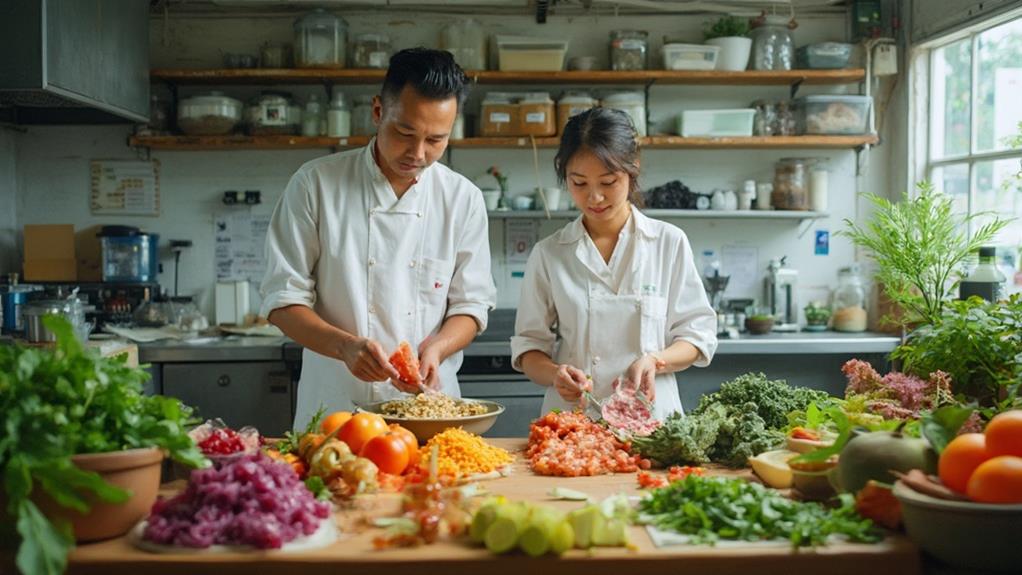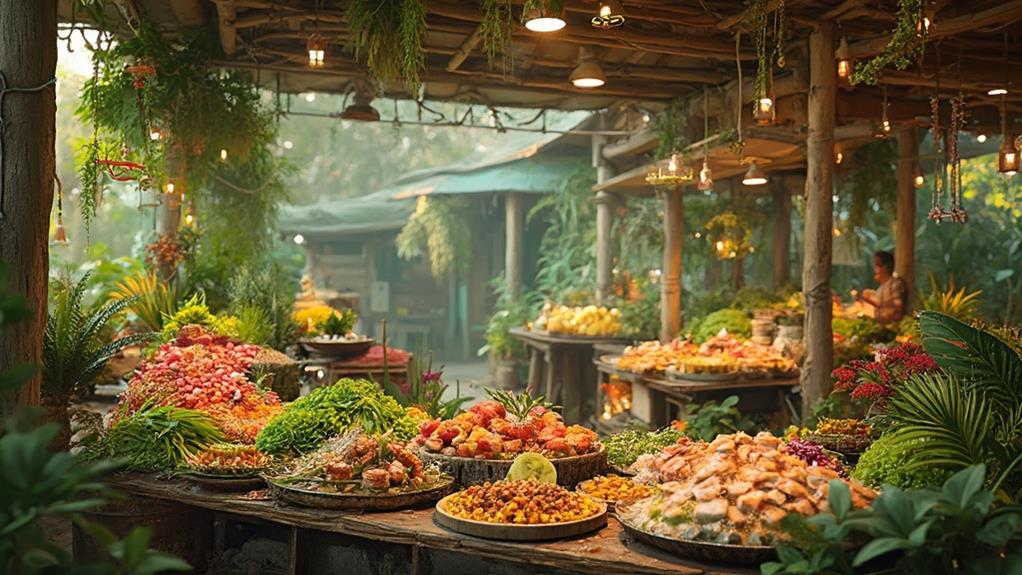Filipino cuisine is undergoing a significant transformation, driven by research and innovation. Traditional dishes are being redefined through nutritional advancements and sustainable practices. For instance, chefs are working with scientists to enhance the nutritional value of classic dishes like adobo and sinigang while maintaining their flavor profiles.
New techniques like molecular gastronomy and fermentation are revitalizing ingredients. One example is the use of malunggay, a leafy green vegetable rich in antioxidants and vitamins, in innovative dishes. These techniques not only create exciting culinary experiences but also provide opportunities to develop new products and flavors.
Emphasizing local sourcing supports farmers and enriches biodiversity. By using locally sourced ingredients, Filipino cuisine can promote sustainable agriculture and preserve the country's biodiversity. This approach also helps to develop rural communities and preserve traditional farming practices.
As the demand for health-conscious options rises, adaptations of classic dishes are emerging. For example, vegan and gluten-free versions of traditional dishes like lechon and pancit are being developed.
These adaptations not only cater to the growing demand for healthier options but also help to preserve culinary identity and elevate Filipino cuisine on a global scale.
Historical Context of Filipino Cuisine
Filipino cuisine is shaped by diverse influences, including indigenous practices, colonial impacts, and trade interactions.
The indigenous peoples of the Philippines initially cultivated local staples such as rice, root crops, and a variety of fruits, laying the foundation for the country's culinary landscape. This foundation allowed for the development of a more complex cuisine over time.
Spanish colonization introduced new ingredients and cooking techniques, merging with local flavors to create dishes like adobo and lechon. The Spanish influence is evident in the use of ingredients like garlic, onions, and tomatoes, which are now staples in Filipino cooking. These ingredients combined with local flavors to create dishes that are uniquely Filipino.
The Chinese influence is evident in staples such as lumpia and pancit. The Chinese introduced noodles, dumplings, and other cooking techniques that were adapted and incorporated into Filipino cuisine. These dishes have become an integral part of Filipino food culture.
American colonization brought canned goods and fast food, further diversifying the culinary scene. The introduction of canned goods and fast food led to the creation of dishes like spaghetti with banana ketchup and fried chicken with rice. These dishes may seem unusual, but they're a testament to the adaptability and resourcefulness of Filipino cuisine.
Food acts as a narrative of cultural identity, resilience, and adaptation. The history of Filipino cuisine reflects the country's social and economic changes throughout history. Understanding this historical context not only enhances appreciation for Filipino cuisine but also informs contemporary discussions about health and innovation in food practices.
The past continues to influence the present.
Innovations in Food Technology
Innovations in food technology are transforming the way Filipinos cook and think about nutrition.
Cutting-edge techniques like molecular gastronomy and fermentation are updating traditional dishes into modern culinary experiences.
Sous-vide cooking, for instance, ensures precise temperature control, leading to better nutrient retention and enhanced flavors.
Advancements in food preservation techniques are extending shelf life without compromising nutritional value. High-pressure processing, for example, allows for the year-round enjoyment of locally sourced ingredients, reducing food wastage while supporting local farmers.
Smart kitchen appliances equipped with AI are making meal prep more efficient. These devices suggest recipes based on available ingredients, promoting creativity in the kitchen and minimizing reliance on processed foods.
Plant-based alternatives are gaining traction, addressing health concerns and sustainability issues. Innovations in plant protein extraction are creating meat substitutes that mimic the texture and taste of traditional Filipino meats, making it easier to adopt healthier diets without sacrificing cultural flavors.
By embracing these innovations, Filipino cuisine is evolving and becoming a vital part of a healthier lifestyle.
Nutritional Research and Development

Filipino cuisine is evolving with advancements in food technology, and nutritional research and development are crucial in shaping healthier eating habits. These research efforts focus on identifying key nutrients in traditional dishes and enhancing their health benefits. For example, researchers are analyzing the nutritional profiles of popular ingredients like malunggay, which is rich in vitamins and antioxidants, and quinoa, a complete protein source.
Innovative food processing techniques are being explored to improve the bioavailability of nutrients and reduce unhealthy components. Fermentation, for instance, can increase the nutritional value of foods, while fortification can enrich them with essential vitamins and minerals.
Additionally, incorporating probiotics into traditional sauces not only enhances flavor but also boosts gut health.
The cultural significance of traditional textiles can inspire new approaches to food production and presentation. The rich cultural heritage of Cordillera textiles and Tboli pis syabit can influence the development of sustainable and eco-friendly food packaging.
Studies on the glycemic index of staple foods can help make informed choices that align with dietary needs. For example, research on the glycemic index of rice, a staple food in the Philippines, can help individuals with diabetes manage their blood sugar levels.
Nutritional research is a bridge connecting traditional Filipino flavors with contemporary health standards. By understanding the nutritional value of traditional dishes and applying innovative food processing techniques, Filipinos can enjoy healthier and more nutritious meals that still honor their cultural heritage.
Sustainable Practices in Agriculture
Sustainable Agriculture: Ensuring a Healthy Environment and Community
Sustainable practices in agriculture are crucial for the long-term health of the environment and communities in the Philippines. By adopting innovative techniques, farmers can contribute to a more resilient food system that prioritizes ecological balance and community well-being.
Preserving Cultural Identity and Community Empowerment
Sustainable agriculture can also contribute to the preservation of cultural identity and community empowerment, much like the cultural significance of traditional textiles.
Additionally, sustainable agriculture can promote the economic empowerment of local farmers, providing them with opportunities to improve their livelihoods.
Effective Sustainable Practices
Crop Rotation: Alternating crops maintains soil fertility and reduces pest buildup, minimizing the need for chemical fertilizers. This practice helps to avoid depleting soil nutrients and reduces the risk of pest infestations.
Agroforestry: Integrating trees with crops enhances biodiversity, improves soil structure, and increases water retention. This approach provides shade, reduces soil erosion, and creates a habitat for beneficial organisms.
Organic Farming: Using natural fertilizers like compost and manure enhances soil health while reducing harmful chemical runoff into water systems. Organic farming promotes a balanced ecosystem and minimizes the environmental impact of agriculture.
Conservation Tillage: Minimizing soil disturbance preserves soil integrity and encourages beneficial microorganisms, leading to healthier crop yields. This practice reduces soil erosion, conserves water, and promotes soil biota.
Benefits of Sustainable Agriculture
Implementing sustainable agriculture practices can mitigate the adverse effects of climate change, enhance food security, and promote economic viability for local farmers.
How Can Research and Innovation Help Balance Tradition and Health in Filipino Food and Nutrition?
Research and innovation in Filipino food can help preserve traditional recipes while improving their nutritional value. By incorporating modern techniques and ingredients, the future of filipino food can maintain its rich cultural heritage while promoting health and wellness in the population.
Health Benefits of Traditional Ingredients

Traditional Filipino ingredients offer numerous health benefits that are often overlooked in modern diets.
Malunggay (moringa) is an excellent source of vitamins A, C, and E, as well as calcium and iron, which can boost the immune system and improve overall well-being.
Incorporating traditional condiments, such as vinegar in adobo, can provide acetic acid, which has been linked to better blood sugar control and is particularly beneficial for those at risk of diabetes.
Additionally, the use of coconut milk, rich in medium-chain triglycerides (MCTs), can enhance metabolic rates and support weight management.
Traditional spices, such as ginger and turmeric, commonly used in Filipino dishes, possess anti-inflammatory properties that can reduce the risk of chronic diseases, including heart disease and arthritis.
Collaborations Between Chefs and Scientists
When exploring the intersection of culinary art and science, collaborations between chefs and scientists can enhance the nutritional value of Filipino cuisine in innovative ways. These partnerships can lead to groundbreaking discoveries that not only elevate traditional dishes but also promote health benefits.
Applying Scientific Principles
By applying scientific principles, chefs can fine-tune recipes to maximize flavor while preserving, or even improving, nutritional content. For example, understanding the Maillard reaction, a chemical reaction between amino acids and reducing sugars, can help chefs optimize the browning process to enhance flavors and aromas.
Inspiration from Cultural Heritage
The rich cultural heritage of Philippine weaving traditions can also inspire innovative approaches to culinary art. The significance of patterns and colors in Philippine textiles, where geometric shapes symbolize unity and strength, can influence the presentation and visual appeal of dishes.
For instance, the use of vibrant colors and geometric patterns on plates can create a visually appealing dining experience.
Potential Outcomes of Collaborations
Collaborations between chefs and scientists can lead to the following outcomes:
- Fermentation Techniques: Boosting probiotics in traditional dishes like bagoong can enhance gut health by utilizing modern fermentation methods.
- Nutrient Analysis: Conducting detailed nutrient profiling of classic ingredients like malunggay (moringa) can inform healthier cooking practices, ensuring that traditional dishes aren't only delicious but also nutritious.
- Flavor Pairing: Researching molecular gastronomy principles can help chefs create unexpected yet harmonious flavor profiles that delight diners, such as pairing sweet and savory flavors.
- Sustainable Sourcing: Collaborating on sustainable farming practices ensures that traditional ingredients aren't only preserved but also environmentally friendly, reducing the environmental impact of food production.
Future Trends in Filipino Food

Filipino Food Trends: Embracing Innovation and Cultural Heritage
The Filipino culinary landscape is undergoing a significant transformation, driven by a blend of innovation and a renewed focus on cultural identity.
Local Ingredients Take Center Stage
Filipino chefs are increasingly emphasizing the use of local ingredients to showcase the country's rich biodiversity.
This farm-to-table movement not only supports local farmers but also promotes sustainability, a critical concern in today's food industry.
For example, restaurants are now incorporating native ingredients like ube, kamote, and labuyo into their dishes.
Fusion Cuisine Gains Momentum
Traditional Filipino dishes are being infused with global flavors, resulting in unique fusion cuisine.
Restaurant menus now feature dishes like adobo tacos and sinigang ramen, reflecting a dynamic culinary dialogue that broadens the appeal of Filipino food.
This trend is made possible by digital platforms that facilitate the sharing of recipes and culinary techniques, preserving heritage while inviting experimentation.
Health-Conscious Adaptations
Filipino cuisine is adapting to evolving consumer preferences by introducing plant-based versions of classic dishes.
Expect to see more plant-based lumpia and lechon, catering to the growing demand for healthier options.
These innovations make Filipino cuisine more accessible and align with global health trends.
As these trends unfold, Filipino food is poised to capture both local and international palates, ensuring its place in the future of global cuisine.
